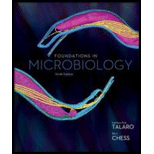
Concept explainers
To analyse:
The origin of viruses and the fact that viruses can so easily enter and get uncoated inside human cells.
Introduction:
Viruses are unique microorganisms that don’t show any signs of life until they come in contact with their specific hosts. Once this contact happens, viruses enter their host cells and use the cellular and genetic machinery of the host cell to multiply. Once their multiplication cycle is over, they are released from the host cell and infect new host cells.
Explanation of Solution
Since viruses are very simple in structure, comprising of only
This is clearly evident in the ease with which viruses are able to enter inside their host cells. The presence of corresponding receptors on the surface of the host cell and the machinery to uncoat viral particles clearly indicate the evolutionary connection between viruses and living cells.
Viruses and living cells seem to be evolutionarily connected.
Want to see more full solutions like this?
Chapter 6 Solutions
Foundations in Microbiology
- ‘’Viruses cannot be grown in standard microbiological culture such as broth and agar. They need to be cultured in the presence of a suitable host such as prokaryotic cells (easiest to grow in the lab), plants and animals because they are unable to reproduce independently in living cells’’.2.2 What are the changes that are brought by a virus to a cell? In your response, make reference to the cytopathic effect (CPE).arrow_forwardMany viruses have the ability to resurrect dead cells. Why investigating this feature of viruses may be relevant to youarrow_forwardExplain one structural distinction between viruses and cells.arrow_forward
- Because viruses lack some of the traits seen in all living things, many scientists do not believe viruses to be genuinely "alive." Using a few characteristics of live organisms as examples, explain why viruses may not be truly "alive."arrow_forwardA virus that typically forms an envelope is now being prevented from budding out of the host cell. Would this virus still be considered infectious? Why or why not? Please explain in detail.arrow_forwardYou are arguing with one of your classmates. They say viruses are living, you say they are not. What argument would you give that they are non-living entities? – Think about the structure and function of virusesarrow_forward
- Which of the following highly contagious viruses is a single-stranded ribonucleic acid (RNA) virus with a helical capsid and envelope and is transmitted by coming in contact with respiratory secretions? "This is a highly contagious respiratory illness transmitted when an infected person coughs or sneezes virus particles into the air," the health department said in a written statement. "It's so contagious that if one person is sick and spreading measles, nine out of 10 people around them who aren't immune will get it, too." Group of answer choices a. Measles b. Parvovirus c. Coxsackie virus A d. Rhinovirusarrow_forwardAs a general rule, viruses are not considered to be alive based on several reasons. One such reason is that some viruses use RNA as their genetic material instead of DNA. Which of the five biological themes does this violate? Briefly explain why.arrow_forwardDefine the terms "latency" and "lysogeny" as they refer to viruses. Describe at least TWO ways these two processes are similar. Describe at least TWO ways these two processes are different.arrow_forward
- Contrast a virus with a cellular organism. and Describe the structure of a virus. and Describe the structure and common shapes of prokaryotic cells. .arrow_forwardThroughout history there are many different types of virus that have caused impacts both small and large. Is there a possibility a virus could be considered a "good virus"? Please provide an argument for both yes and no with the use of a proper example, facts and conceptual information.arrow_forwardIs a Virus considered living or non-living (Justify the answer)? Give one example of a virus.arrow_forward
 Human Anatomy & Physiology (11th Edition)BiologyISBN:9780134580999Author:Elaine N. Marieb, Katja N. HoehnPublisher:PEARSON
Human Anatomy & Physiology (11th Edition)BiologyISBN:9780134580999Author:Elaine N. Marieb, Katja N. HoehnPublisher:PEARSON Biology 2eBiologyISBN:9781947172517Author:Matthew Douglas, Jung Choi, Mary Ann ClarkPublisher:OpenStax
Biology 2eBiologyISBN:9781947172517Author:Matthew Douglas, Jung Choi, Mary Ann ClarkPublisher:OpenStax Anatomy & PhysiologyBiologyISBN:9781259398629Author:McKinley, Michael P., O'loughlin, Valerie Dean, Bidle, Theresa StouterPublisher:Mcgraw Hill Education,
Anatomy & PhysiologyBiologyISBN:9781259398629Author:McKinley, Michael P., O'loughlin, Valerie Dean, Bidle, Theresa StouterPublisher:Mcgraw Hill Education, Molecular Biology of the Cell (Sixth Edition)BiologyISBN:9780815344322Author:Bruce Alberts, Alexander D. Johnson, Julian Lewis, David Morgan, Martin Raff, Keith Roberts, Peter WalterPublisher:W. W. Norton & Company
Molecular Biology of the Cell (Sixth Edition)BiologyISBN:9780815344322Author:Bruce Alberts, Alexander D. Johnson, Julian Lewis, David Morgan, Martin Raff, Keith Roberts, Peter WalterPublisher:W. W. Norton & Company Laboratory Manual For Human Anatomy & PhysiologyBiologyISBN:9781260159363Author:Martin, Terry R., Prentice-craver, CynthiaPublisher:McGraw-Hill Publishing Co.
Laboratory Manual For Human Anatomy & PhysiologyBiologyISBN:9781260159363Author:Martin, Terry R., Prentice-craver, CynthiaPublisher:McGraw-Hill Publishing Co. Inquiry Into Life (16th Edition)BiologyISBN:9781260231700Author:Sylvia S. Mader, Michael WindelspechtPublisher:McGraw Hill Education
Inquiry Into Life (16th Edition)BiologyISBN:9781260231700Author:Sylvia S. Mader, Michael WindelspechtPublisher:McGraw Hill Education





